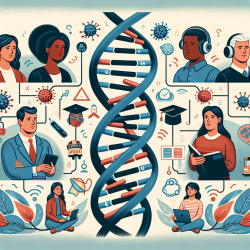Introduction
In the realm of special education, understanding the genetic underpinnings of neurological disorders can significantly enhance the support we provide to students with unique learning needs. The recent research article titled "Heterozygous nonsense variants in the ferritin heavy-chain gene FTH1 cause a neuroferritinopathy" offers valuable insights into a newly identified pediatric neurodegenerative disorder. This blog explores how these findings can be leveraged by practitioners in special education to improve their skills and encourage further research.
Understanding Neuroferritinopathy
Neuroferritinopathy is a disorder characterized by neurodegeneration with brain iron accumulation (NBIA). The study identifies that heterozygous nonsense variants in the FTH1 gene, which encodes the ferritin heavy chain, are linked to this condition. The research highlights the clinical, neuroimaging, and neuropathological findings of five unrelated pediatric patients with de novo heterozygous FTH1 variants. These children presented with developmental delays, epilepsy, and progressive neurological decline.
Implications for Special Education Practitioners
For special education practitioners, these findings underscore the importance of genetic screening and early diagnosis in children presenting with developmental delays and neurological symptoms. Understanding the genetic basis of such conditions can lead to more personalized educational strategies and interventions. Here are a few ways practitioners can implement these insights:
- Early Identification: Encourage genetic testing for students with unexplained developmental delays or neurological symptoms to identify potential underlying genetic causes.
- Personalized Interventions: Use genetic information to tailor educational plans that address the specific needs and challenges faced by students with neuroferritinopathy.
- Collaboration with Medical Professionals: Work closely with healthcare providers to integrate medical insights into educational strategies, ensuring a holistic approach to student support.
Encouraging Further Research
The study also suggests potential therapeutic strategies, such as the use of antisense oligonucleotides to target mutant FTH1 transcripts, which could ameliorate the condition. This opens avenues for further research into treatment options that could improve the quality of life for affected individuals.
Special education practitioners can play a pivotal role in this research by:
- Participating in Studies: Engage in collaborative research efforts to explore the educational impacts of genetic disorders and potential interventions.
- Advocating for Resources: Advocate for funding and resources to support genetic research and the development of specialized educational programs for affected students.
- Sharing Knowledge: Disseminate research findings within the educational community to raise awareness and promote best practices.
Conclusion
As special education practitioners, staying informed about the latest genetic research is crucial in providing effective support to students with complex needs. The insights from the FTH1 gene study offer a pathway to enhance educational strategies and encourage further exploration into therapeutic interventions. By integrating these findings into practice, we can better support our students' educational journeys and overall well-being.
To read the original research paper, please follow this link: Heterozygous nonsense variants in the ferritin heavy-chain gene FTH1 cause a neuroferritinopathy.










